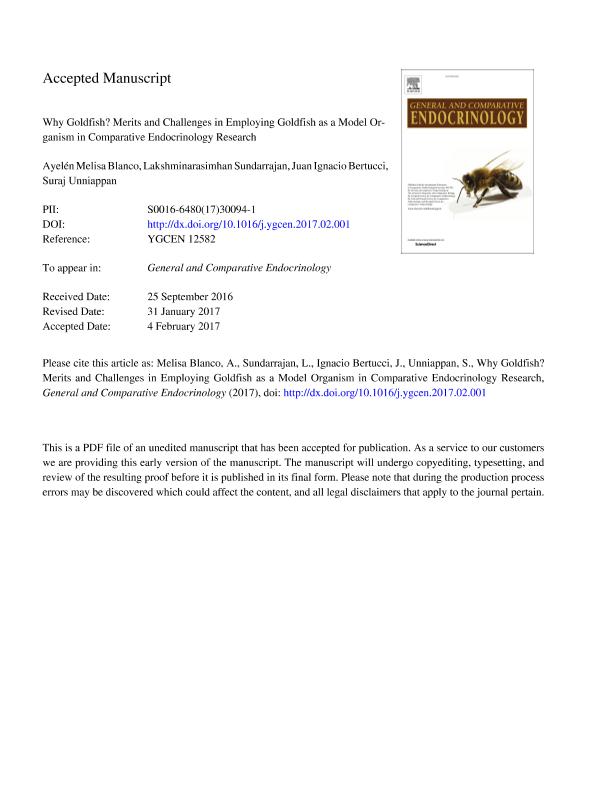Mostrar el registro sencillo del ítem
dc.contributor.author
Blanco, Ayelén Melisa
dc.contributor.author
Sundarrajan, Lakshminarasimhan
dc.contributor.author
Bertucci, Juan Ignacio

dc.contributor.author
Unniappan, Suraj
dc.date.available
2018-06-13T15:07:26Z
dc.date.issued
2018-02
dc.identifier.citation
Blanco, Ayelén Melisa; Sundarrajan, Lakshminarasimhan; Bertucci, Juan Ignacio; Unniappan, Suraj; Why goldfish? Merits and challenges in employing goldfish as a model organism in comparative endocrinology research; Academic Press Inc Elsevier Science; General and Comparative Endocrinology; 257; 2-2018; 13-28
dc.identifier.issn
0016-6480
dc.identifier.uri
http://hdl.handle.net/11336/48510
dc.description.abstract
Goldfish has been used as an unconventional model organism to study a number of biological processes. For example, goldfish is a well-characterized and widely used model in comparative endocrinology, especially in neuroendocrinology. Several decades of research has established and validated an array of tools to study hormones in goldfish. The detailed brain atlas of goldfish, together with the stereotaxic apparatus, are invaluable tools for the neuroanatomic localization and central administration of endocrine factors. In vitro techniques, such as organ and primary cell cultures, have been developed using goldfish. In vivo approaches using goldfish were used to measure endogenous hormonal milieu, feeding, behaviour and stress. While there are many benefits in using goldfish as a model organism in research, there are also challenges associated with it. One example is its tetraploid genome that results in the existence of multiple isoforms of endocrine factors. The presence of extra endogenous forms of peptides and its receptors adds further complexity to the already redundant multifactorial endocrine milieu. This review will attempt to discuss the importance of goldfish as a model organism in comparative endocrinology. It will highlight some of the merits and challenges in employing goldfish as an animal model for hormone research in the post-genomic era.
dc.format
application/pdf
dc.language.iso
eng
dc.publisher
Academic Press Inc Elsevier Science

dc.rights
info:eu-repo/semantics/openAccess
dc.rights.uri
https://creativecommons.org/licenses/by-nc-sa/2.5/ar/
dc.subject
Advantages
dc.subject
Comparative Endocrinology
dc.subject
Goldfish
dc.subject
Model Organisms
dc.subject
Neuroendocrinology
dc.subject
Techniques
dc.subject
Tools
dc.subject.classification
Otras Ciencias Biológicas

dc.subject.classification
Ciencias Biológicas

dc.subject.classification
CIENCIAS NATURALES Y EXACTAS

dc.title
Why goldfish? Merits and challenges in employing goldfish as a model organism in comparative endocrinology research
dc.type
info:eu-repo/semantics/article
dc.type
info:ar-repo/semantics/artículo
dc.type
info:eu-repo/semantics/publishedVersion
dc.date.updated
2018-06-13T14:16:05Z
dc.journal.volume
257
dc.journal.pagination
13-28
dc.journal.pais
Estados Unidos

dc.journal.ciudad
Nueva York
dc.description.fil
Fil: Blanco, Ayelén Melisa. University of Saskatchewan; Canadá. Universidad Complutense de Madrid; España
dc.description.fil
Fil: Sundarrajan, Lakshminarasimhan. University of Saskatchewan; Canadá
dc.description.fil
Fil: Bertucci, Juan Ignacio. University of Saskatchewan; Canadá. Consejo Nacional de Investigaciones Científicas y Técnicas. Centro Científico Tecnológico Conicet - La Plata. Instituto de Investigaciones Biotecnológicas. Instituto de Investigaciones Biotecnológicas "Dr. Raúl Alfonsín" (sede Chascomús). Universidad Nacional de San Martín. Instituto de Investigaciones Biotecnológicas. Instituto de Investigaciones Biotecnológicas "Dr. Raúl Alfonsín" (sede Chascomús); Argentina
dc.description.fil
Fil: Unniappan, Suraj. University of Saskatchewan; Canadá
dc.journal.title
General and Comparative Endocrinology

dc.relation.alternativeid
info:eu-repo/semantics/altIdentifier/doi/https://dx.doi.org/10.1016/j.ygcen.2017.02.001
dc.relation.alternativeid
info:eu-repo/semantics/altIdentifier/url/https://www.sciencedirect.com/science/article/pii/S0016648017300941
Archivos asociados
